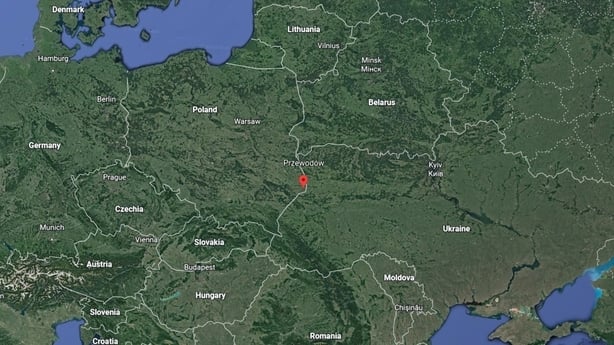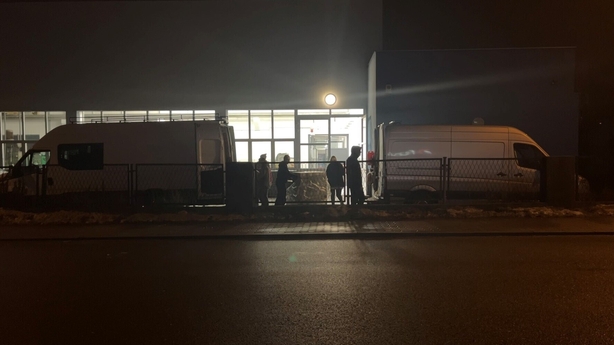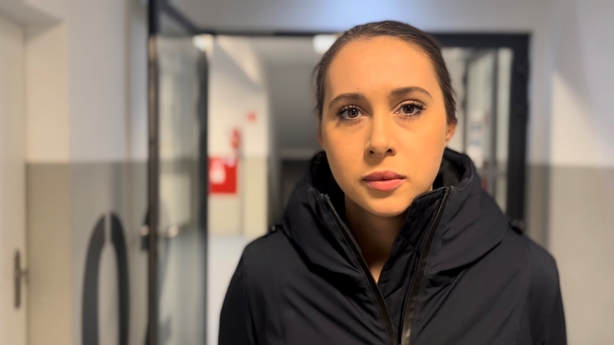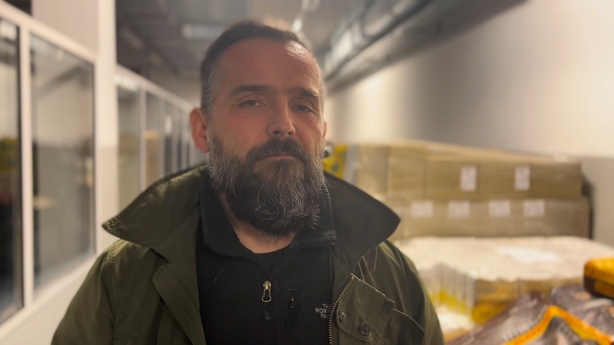Many Poles will remember 2022 as the year when Russian militarism once again threatened the stability of their state.
In Poland, where the devastation of the Second World War and 45 years of Moscow-imposed Communist rule still pervades the collective memory, Russia’s invasion of Ukraine often felt too close for comfort.
Tell-tale signs of the war next door are plain to see in Poland’s cities and towns.
There remains a regular flow of refugees and aid across the Polish-Ukrainian border. In main train stations, information points in Ukrainian offer advice to newly arrived refugees.
In Warsaw, digital billboards now feature advertising in Ukrainian Cyrillic lettering and the sound of Ukrainian and Russian being spoken has become commonplace - a rarity when I previously lived in Poland almost a decade ago.
Fewer refugees are arriving of late but go to any main train or bus station and you will be confronted with a now familiar sight: Ukrainian mothers with young children, sometimes with a grandparent, their belongings hauled in jaded 20kg wheelie cases.
In mid-November the war landed abruptly on Polish soil when two farmers in a village close to the border with Ukraine were killed by a stray rocket. For a few brief hours, the West (and Twitter) debated over whether the rocket had been launched by Russia.
Poland’s government held an emergency national security meeting, put its army on alert and considered whether to invoke Article 4 of NATO’s treaty, which calls for a meeting of NATO allies in the event that the security of one ally is under threat.
As it transpired, a stray Ukrainian rocket was to blame for the farmers’ deaths. It was a reminder to Poles that the war remains very close indeed.

Changing demographics
Poland’s government and the country’s President Andrzej Duda have been steadfast in their support of Ukraine’s efforts to repel Russia’s invasion. The latest figures from the Kiel Institute for the World Economy, a German think tank, ranks Poland as the fifth largest donor of military and humanitarian aid to Ukraine this year – it has donated just over $3bn. That’s equivalent to about 0.5% of Poland’s GDP.
On the plight of Ukrainian refugees, Poland has scored well too.
The country’s governing right-wing party, Law and Justice, has towed a hard-line stance on immigration since coming to power in 2015, particularly when it comes to refugees and asylum seekers from the Middle East, Pakistan and Afghanistan attempting to cross the Polish-Belarussian border.
But from day one of Russia’s invasion, the government pulled out all the stops to accommodate Ukrainian refugees arriving in the country. NGOs such as Amnesty International criticised Polish authorities for double standards on the issue.
Ukrainian nationals living in Poland can apply for national insurance numbers, enabling them to work legally and access the country’s healthcare and social security system.
An outpouring of grassroots humanitarian support from Polish citizens to help and host the arrival of three million Ukrainian refugees – mostly women and children – within the first month of the war will remain an abiding memory of 2022 for many in Poland.

As many as 7% of Poles hosted Ukrainian refugees in their homes and one in three Polish citizens volunteered to help refugees in some form during the first five months of the war, according to a study by the Polish Economic Institute.
Poland’s Ukrainian population may well end up staying for much longer than they had ever intended.
The UNCHR places the number of Ukrainian refugees registered for temporary protection in Poland at just over 1.5m people – the largest number for any EU country. (In total, eight million Ukrainians have crossed the border into Poland since the start of the war, many heading on to western EU states.).
Before the war an estimated one million Ukrainian nationals – mostly workers on temporary visas – were already resident in Poland. So 2.5m Ukrainians may now be living in Poland.
This is changing Poland’s demographics, a country of 38m and one of Europe’s most homogenous. Polish nationals accounted for 98% of the population according to the 2021 census.
Many Ukrainians I have spoken to in recent weeks hope to return home when it is safe to do so.
But Russia’s recent tactic of bombarding Ukraine’s electricity infrastructure – leaving many large towns and cities in eastern Ukrainian without power – and renewed attacks by President Vladimir Putin’s forces along the eastern front have deterred many from returning to their homes this winter.
Grassroots support

As the year progresses and the war dragged on, Ukrainian refugees, as is the case in Ireland, began to settle in smaller towns across Poland.
Two days before Christmas I visited the town of Tarnowskie Góry in Silesia, southern Poland – the country’s coal-mining heartland.
The town is almost 400km from the border with Ukraine and has a population of about 61,000 residents. But even here, around the town’s pretty square, a smattering of Ukrainian and Russian can be heard.
Again, it is the familiar sight of women and young children who have arrived since the start of the war. Ukrainian men are seldom seen here. Many are back home fighting.

On a wet and cold Friday evening – the night before Christmas Eve – I meet a group of local Polish and Ukrainian volunteers from a charity called 'Szaliki’ (meaning ‘scarves’ in English) as they pack two vans full of food packages and clothes before driving through the night to deliver the supplies to Lviv.
The aid was donated by a branch of the German Red Cross and local residents.

The charity’s co-founder, Sarah Johanna-Hamera, a 30-year-old digital marketing professional from Tarnowskie Góry explains that she had volunteered to help refugees at the Polish border from the first day of the war. She stayed at the border for six weeks.
As increasing numbers of Ukrainian refugees began to arrive in Sarah’s home town, she and another local volunteer, Pawel Sienko, decided to set up ‘Szaliki’ in April. Other volunteers soon flocked to the cause.
Eight months later, a rotating team of five to ten volunteers from a total of 50 local volunteers help to distribute food and clothes to refugees on Tuesday and Thursday evenings between 4pm and 7pm.

On those evenings, Ukrainian refugees – they are entirely women and young children on the night I visit – receive neatly packed plastic bags of rice and pasta. There are tea bags, chocolate, shampoo and nappies. Cans of spam are stacked next to dozens of boxes containing donated winter jackets.
Sometimes washing machines and wheelchairs are donated.
"Most of the people arrive with little children and just their documents because they hadn’t enough time to pack. They hear that the Russians are coming and just take their children and you go. They have to start from zero," says Sarah.
The local county council estimates that at least 2,500 Ukrainian refugees live in the town and surrounding county area.

Mariusz Gasior, a 47-year-old museum curator, is another local volunteer. He tells me that he sees it as his duty to help the refugees.
"It’s a very difficult time for the Ukrainian people. They have to win this war. By helping the women and children here we take a little bit of burden from Ukrainian society so they can deal more efficiently with the Russian forces," says Mariusz in an unmistakable London accent. He tells me he worked at London’s Imperial War Museum for 14 years.
This scene from one small Polish town suggests that ten months into Mr Putin’s war, Poland’s grassroots activists remain dedicated to helping their neighbours.
From enmity to amity

Poland and Ukraine have not always shared the warmest of relations.
For centuries, a sizeable chunk of what is now western Ukraine, including Lviv, was part of Poland. (with the exception of 1772 to 1918 when the region formed part of the Austro-Hungarian empire).
Under German Nazi occupation during the second world war, Ukrainian partisan nationalists, intent of carving out a post-war independent Ukraine, murdered thousands of ethnic Poles in the provinces of Volhynia and Eastern Galicia.
Poland’s Institute of National Remembrance estimates that, between 1943 and 1945, as many 100,000 Polish civilians were killed during this sectarian onslaught.
Poland’s steadfast support for Ukraine throughout 2022 – borne partly out of a shared aversion towards Russian imperialism – has redefined relations between the two countries for the better.
Shows of solidarity between Warsaw and Kyiv became a regular occurrence throughout the year.
Prime minister Mateusz Morawiecki made an early visit to Kyiv on 15 March, only three weeks after the start of the war, along with the PMs of the Czech Republic and Slovakia, to meet with Ukraine’s President Volodymyr Zelensky and reaffirm the European Union’s financial and moral support for Ukraine.
Mr Zelensky and his Polish counterpart, President Andrzej Duda, enjoy warm relations too.
Mr Duda has met Mr Zelensky twice in Kyiv since the start of the war and the two heads of state met again on Polish soil last week after Mr Zelensky returned from his historic trip to Washington DC.
Attitudes in Poland towards dealing with Russia remain some of the sternest in the EU.
Sixty-three percent of Poles don’t believe that the West’s sanctions against Russia went far enough, according to a survey in August by YouGov, a UK pollster – the highest among any EU respondents.
Support for any direct military action against Russia is much lower however.
Russia’s war in Ukraine looks likely to drag on through 2023. As long as that remains the case, Poland’s support for its neighbour – both in terms of military support and humanitarian aid – will continue unabated.
For Warsaw, the alternative of not supporting Ukraine to the hilt would spell the unthinkable – a Russian army threatening Poland’s (and NATO’s) eastern border. Poles do not want that version of the future.







